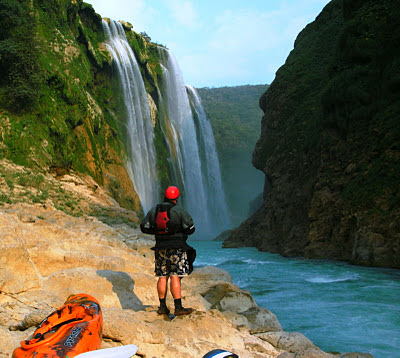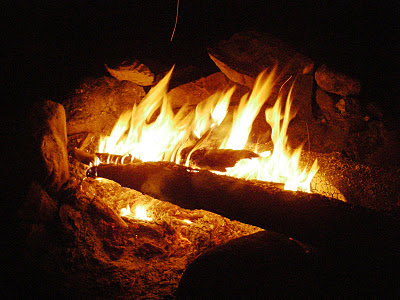
Below: Adam on the Rio Santa Maria, photo by Steve Krajewski

Since my first trip to the Huasteca region of Mexico in 2005, I have returned almost ever winter for 2-3 weeks to revisit my favorite rivers in the area and explore new ones as well. There is an abundance of rivers in the region with a variety of options depending on water levels. Most recently, Steve Krajewski, Mark Newton, and I drove south from Alabama to spend a couple of weeks enjoying the warm waters and sunshine provided by the Huasteca region in December of 2011. Despite lower than normal water levels, we had good weather and an awesome time paddling many of the classic and a few not-so-classic rivers in the area.
Below: Mark on the Rio Verde, photo by Adam Goshorn

Below: Jorge and Steve cross a bridge over the Rio Moctezuma, photo by Adam Goshorn

Mexico is a huge country with a 31 states that form a landmass larger than Alaska and California combined. Many regions in Mexico contain great whitewater, so one might wonder why I keep returning to the same area year after year. The answer is simple… MONEY. I would love to kayak in Veracruz, Chiapas, Oaxaca, and other parts of Mexico (and I hope to in the future), but the Huasteca region is the closest, most accessible whitewater when driving from the southeastern United States. Its proximity alone makes it by far the cheapest destination in Mexico and easily half as expensive as any fly-in tropical destination in Central or South America.
Below: Mark on the Rio Valles, photo by Adam Goshorn

Below: Adam on the Rio Valles, photo by Steve Krajewski

I’ve worked hard keep kayaking a big part of my life and my success in doing so is due in part to keeping cost as low as possible. I have a job that allows me time to kayak around the southeast throughout the year and I am usually able to take two or three bigger trips outside of the southeast each year, but the key to all of it is trimming cost any way that I can. The ability to drive to Mexico is what makes it such a cheap destination, but it’s the driving that also would make it more expensive to continue to the other regions beyond Huasteca. In December of 2011, our total group cost per person for the entire trip, including all of our food, gas, border fees, camping fees, etc., came out to a mere $750 each. The next closest area with such a tight concentration of great paddling would be Varacruz, but the drive south adds around eight hours (plus the 8 hour return trip) easily adding over $100 to the total per person cost of the trip.
Below: Steve on the Rio Valles, photo by Adam Goshorn

Below: Mark on the Rio Santa Maria, photo by Steve Krajewski

In December of 2011 we spent multiple days running laps on the classic El Salto and Cascadas Micos sections of the Rio Valles. Despite low water, we were still able to run the 3rd and 4th canyons of the Rio Santa Maria finishing at the famous Cascada de Tauml. We also spent a few days traveling and paddling with my fiend Jorge Marquez. Jorge is Doctor in Tamazunchale and I met him in on the Cascadas Micos in 2005 during my first trip to the region. In the years since we have kept in touch and when possible we have connected whenever I was in the area. This time, we took him down the 2nd canyon of the Rio Verde for his first time. Then he took us south into the state of Hidalgo, where I had not previously paddled, to spend a few days paddling sections of the Rio Moctezuma and Rio Amajac.
Below: Video from our 2011 trip, edited by Adam Goshorn
Every once in a while I wonder if someday I will look back at the years of my life I have devoted to the paddling and regret not choosing a path that might have led to increased wealth and professional advancement. I certainly cannot imagine feeling that way now, but I sometimes wonder how long can I continue to choose planning for paddling over planning for life outside paddling? Will I always consider these decisions to be the right ones? Is it possible to live this way into old age?
Below: Adam and Mark on the Rio Santa Maria, photo by Steve Krajewski

Below: Adam at Cascada de Tamul, photo by Steve Krajewski

Having just returned from spending most of December on the road (in Mexico and elsewhere), I feel affirmed in my life decisions. I am relaxed, rejuvenated, and ready to work hard as the busiest part of work-year begins. I’m ready for the hard work ahead and the next adventure, whatever that may be… and that is what paddling continues to give me more than 20 years after I began canoeing with my dad in a rural area in Virginia. For me, paddling keeps life fresh, keeps me excited, and continues to create the best memories anyone could hope for.
Below: The group takes a break on the Rio Amajac, photo by Steve Krajewski

Below: Steve on the Rio Verde, photo by Adam Goshorn

Until Next Time...
Adam Goshorn
Below: Mexico scenery, photo by Steve Krajewski

Below: Driveway to Agua Azul, photo by Steve Krajewski

Below: Sunset over a swamp, photo by Adam Goshorn

| kayak session |














